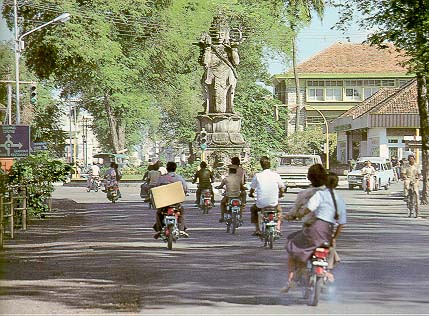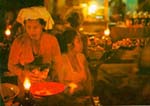
Denpasar
|
|
With a
population over
100,000, and Bali's capital. It is the largest city on the island. It
is also the capital of the Badung kabupaten (regency). Denpasar was the
site of a suicidal battle of the rajas of Badung against the Dutch
Militia in 1906. A large open square in the centre of the city, named
Puputan Square, commemorates the event. It has grown quickly into a
bustling little city full of general stores, art shops, restaurants,
banks, and narrow streets, many of them one-way that can barely handle
the crush of traffic.
|

|
|
Jalan
Veteran and the
little street between Puputan Square, behind the Bali Hotel are good
places to buy handicrafts. Many shops close between 1 pm and 5 pm, but
thereafter stay open until 8 pm. The population is mostly Balinese who
speak a dialect of Indonesian written in Pallava script and practice a
form of Islam strongly influenced by Hindu customs.
|

|
|
In
addition, there are
Arab and Indian merchants who deal mainly in textiles; Chinese operate
most local businesses, and there are some Christians. The city's
mechanized industries include food processing, papermaking and
printing, and the manufacture and repair of machinery. Handicrafts
include sandstone carving, weaving, coconut and bone carving, plaiting,
basket weaving, and the production of gold and silver jewelry.
|
|
The Museum
Bali, built
by the Dutch government in 1932, presents an excellent survey of
Balinese art from prehistoric times to the early 20th century. Items
range from Neolithic stone implements, Metal Age sarcophagi, and
Buddhist and Hindu bronzes through a fine variety of modern
woodcarvings and paintings, to ceremonial masks and ukurs-human figures
made from silver and Chinese coins used in death rituals. The
architecture of the museum combines the two principal edifices in Bali:
the temple and the palace. The split gate, the outer and inner
courtyards and kulkul ("alarm drum") tower are characteristic of the
temple. Opposite the kulkul stands an elevated pavilion once used in
palaces as a lookout for a prince viewing his lands. The main building
with its wide, pillared veranda resembles the Karangasem palaces of
East Bali, where the porch once served ministers and authorities who
had an audience with the raja. The windowless building on the right
reflects the Tabanan palace style of West Bali, while the brick
building on the left belongs to the northern palace style of Singaraja,
making the museum a true monument to Bali.
|
|
A
permanent exhibition
of modern Balinese painting and wood carving may be seen at the Art
Center at Abiankapas on the edge of the city. This grandiose complex
includes a large dance arena and a sales room. Exhibitions, dances, and
recitations of classical literature are organized by the center. A
calendar of events is available. Visiting hours are 8 a.m. to 5 p.m.,
Tuesday to Sunday.
|
|
A network
of roads links
Denpasar with Singaraja and other cities on the island. Denpasar also
has an international airport. A branch of the National Archaeological
Research Centre; the Bali Museum, built by the Dutch government in 1932
and containing specimens of Balinese art from prehistoric times to the
early 20th century; and Universitas Udayana (founded 1962) are located
at Denpasar. Sites of interest include the Puri (temple) Pemecutan, St.
Joseph Church, Meredith Memorial Library, Pasar (market) Dadung, Kokar
(Conservatory of Performing Arts), Academy of Indonesian Dances, and
Abiankohas Art Centre. Pop. (1980) 261,263.
|
Copyright
2001-2015, K&D Bali Designs. All rights reserved.
|